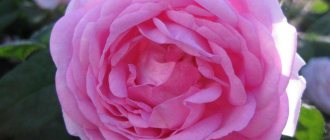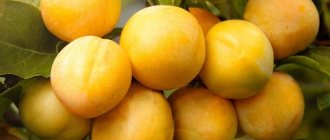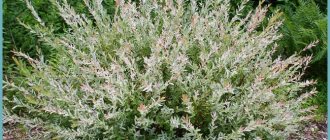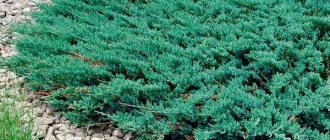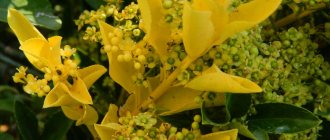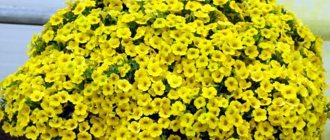Names and descriptions of miniature varieties of roses
For the first time, miniature roses came to European territory from China back in 1810, but they became widespread only after 1918, in which Dr. Roulette from Switzerland played an important role. It was she who first began to propagate mini-roses, thanks to which in our time breeders have managed to obtain more than a dozen different varieties.
All of them share the following characteristics:
- bush height no more than 10–35 cm (for indoor floriculture);
- small, dark green leaves with a shiny surface;
- thin but strong spikes;
- small double and cup-shaped flowers with a diameter of 1–3 cm (can be single or collected in inflorescences);
- long and abundant flowering throughout the summer.
As for specific varietal variations, the following varieties are considered one of the most popular in home floriculture:
- "Green Ice Min" is a low-growing plant 20–24 cm high, with pointed buds, greenish-white in color. The color of the flowers varies from pure white to soft green, but all of them do not exceed 2–2.5 cm in diameter. Each flower has about 40–45 fragrant petals, which give the flowers their “double” appearance. The leaves of the plant are light green in color, leathery and shine well in the sun. The bushes are semi-spreading, so they do not always need to be tied. If all conditions for the development of the rose are created, flowering will always be abundant, especially since “Green Ice Min” is a winter-hardy variety and is highly resistant to diseases.
- “Baby Masquerade” is a profusely flowering variety, represented by plants with a shoot height of up to 35 cm. The cup-shaped flowers are painted in a rich yellow color, gradually turning into pink-red. The diameter usually does not exceed 4 cm, and each flower has about 30–40 petals, with a light and pleasant aroma. The leaves are leathery and shine well in the light. The variety is winter-hardy and tolerates drought well. Suitable for both planting in pots and marking borders.
- "Daniela" is a relatively young French variety, bred only in the 90s of the last century. In comparison with the previous ones, it is even more compact, because the height of its shoots does not exceed 20 cm. The flowers are large, rosette-shaped, with slightly pointed pink petals. The flowering is very abundant, and its peculiarity is the almost complete lightening of the flower petals towards the end of the season. “Daniela” can be grown not only as a potted crop, but also for pragmatic purposes: for example, to create boutonnieres, but do not forget that the variety is afraid of frost and requires shelter for the winter. Resistance to pests and diseases is much higher.
- “Coraline” - rose bushes grow up to 30 cm in height and differ from the rest in their long flowering period. Coral-red flowers do not have a pronounced aroma, but at the same time this does not prevent florists from using them in flower arrangements. The shoots of the bush are densely leafy, the leaves are oval, rich green in color. “Coraline” has good disease resistance and is characterized by high ease of care, both when grown indoors and when placed on balconies or terraces.
- "Hummingbird" is one of the old varieties of miniature roses, which was bred at the beginning of the 19th century. Compared to other varieties, its flowers seem even more unique, as they have a rich apricot-orange hue. The height of the bushes of these roses usually does not exceed 25 cm, the leaves are leathery, glossy, dark green. The inflorescences contain 3–4 fragrant orange flowers. Rose blooms begin in summer and continue until late autumn, until the first frost hits. The “Hummingbird” variety is often used not only in indoor, but also in garden floriculture, using it to frame flower beds or create ridges. Small roses often become the basis for wedding boutonnieres.
- "Lavender Jewel" is a low-growing plant, reaching a height of 15 cm. The mauve flowers of this rose are small (up to 3.5 cm in diameter), collected in inflorescences, slightly fragrant. The bushes look compact and densely leafy. The leaves are dark green and glossy. Flowering is abundant. In addition to growing in pots, Lavender Jewel can also be useful for creating beautiful living borders, especially since it has high winter hardiness.
History, features, advantages of small species
The birthplace of spray roses is Ancient China. Small varieties suitable for growing indoors were also bred there. They were brought to Europe at the beginning of the 19th century, but their selection began seriously only in 1918, when a miniature bush strewn with flowers was found by the Swiss Roulette.
Related article:
Rose Super Dorothy - description and characteristics of the climbing variety
The main feature is what a miniature rose bush looks like:
- height from 15 to 50 cm,
- dense foliage,
- abundance of buds,
- flower diameter no more than 2 cm,
- long flowering.
Botanists and simple gardeners are engaged in breeding the species, and both are successful. The number of varieties has long exceeded 150, and this is only in the “dwarf” subspecies.
The list of advantages of dwarf bush roses includes a wide color palette, no less than that of classic species, small but fragrant buds, dense foliage of a juicy dark green hue. Some varieties are characterized by a change in the color of buds and foliage as the bush ages, and several (up to 3 per season) waves of flowering.
Dwarf roses were participants in experiments in space - in 2002, with the help of the “Night Aroma” variety bush, the influence of gravity on the development and aroma of plants was studied.
The virtues of small roses
In comparison with the usual large buds on long stems, miniature varieties of roses seem not so impressive to many, but they also have a number of advantages that can convince them of the appropriateness of planting.
Important! Considering the small size of miniature roses and the relatively low density of bushes of many species, to increase their decorative value, it is better to plant several plants at once (provided there is a sufficient amount of nutrients).
- First of all, it is worth noting the following features:
- Dwarf varieties up to 45 cm high always grow in compact groups. Their shoots do not spread on the ground, do not form arches and do not require garter.
- Despite the small size of the sheet plates, their decorative effect is enhanced by the large number and glossy, shiny surface.
- On different bushes there are fragrant flowers with a variety of shades: red, orange, yellow, pink, white and even green or purple. There are also varieties with two-tone color, which looks very unusual, but at the same time quite attractive.
- Some miniature roses are capable of changing the color of their flowers with age (for example, “Daniela”), and these changes can affect a completely unexpected color palette: sometimes the color changes from rich yellow to dark red.
- Most varieties are characterized by double compact inflorescences, 3–15 flowers each, which only adds even more elegance to the bush.
- The flowering of mini roses is quite long, and if optimal conditions are created, you can enjoy their beauty from May until the first frost, and this is only if you are not going to take the plant indoors for the winter. Potted roses often bloom even longer.
- If the shoots of crops planted in the garden freeze a little over the winter, then in the spring you can simply cut them off without worrying about the abundance of flowering. It will not suffer from this in any way.
- When growing small flowers in the garden, you don’t have to worry about the usual pests and diseases, because compared to large roses, the mini version is more resistant to them.
As a pleasant addition to the list of advantages of mini roses, we can note the ease of propagation by cuttings, which in some cases often becomes the only way to obtain more plants.
As for the existing disadvantages of small varieties, the main ones include the almost complete absence of aroma and increased demands on living conditions.
Did you know? Natural oil obtained from roses is one of the most expensive in the world. This is not surprising, because to prepare one kilogram of product you will need at least 3 tons of plant petals.
Queen of all flowers - the majestic rose
The rose was bred from the collective varieties of the Rosehip genus, represented by more than 300 species. It was domesticated and crossed many times.
As a result, a wide variety of plants of different colors and aroma was obtained. It follows from this that the flower that pleases the eye in gardens and parks is the result of crossing two branches of cultivated plants, from the east and the west.
Western varieties. It is possible that man first showed interest in roses when he invented writing or the wheel. Even in the second millennium BC on the island of Crete, the walls of palaces were painted with buds. These flowers were also depicted on pharaoh’s tombs. Theophastus was the first to describe plant varieties and their care; he is considered the father of botany. And the first to call her “the queen of flowers” was the ancient Greek poetess Sappho.
The first to cultivate and grow these plants in pots for decoration were the ancient Greeks. The Romans created a real cult of the queen of flowers; the petals were eaten, wine and cosmetics were made from them.
Eastern varieties. Ancient China began to grow them when Western civilization was emerging. They were the first to make rose oil to use in perfumes and to ward off evil spirits. The eastern species were not large, with a weak aroma, but the bush was completely covered with buds and bloomed all season.
In the eighteenth century they were brought to Europe. And already in the nineteenth, the first aristocrat was brought to our continent - a tea rose, which has a beautiful glass and a wonderful aroma. But she loved the warmth.
New varieties were obtained from small Chinese and tea varieties, as well as from frost-resistant ones that grew in Great Britain. They bloomed longer and withstood cold weather.
In remontant plants, flowering was long and abundant, but lacked brightness. The tea varieties were beautiful, they had a wonderful aroma, but they did not tolerate frost. Breeders did painstaking work and in the second half of the 19th century they grew the first hybrid tea rose.
How to choose in a store
By and large, the rules for choosing roses of low-growing varieties are not much different from the recommendations for purchasing ordinary ones, so in any case, the gardener should consider the following:
- Always choose only healthy plants, without visible mechanical damage or signs of disease and pest activity.
- Never buy discounted bushes, even if at first glance they seem normal to you (not a single seller will work at a loss, which means there are still questions about a specific specimen).
- Carefully inspect not only the top part of the flower, but also pay attention to the pot, looking into the drainage holes: no sprouted roots should be visible from them.
- The selected bush should be compact in size, but with a large number of buds, otherwise the opened flowers will not please you for long.
- The plant should not be overgrown, because even if there are no traces of mold on it, it is likely that it will soon appear (the first sign is a grayish coating on the bottom of the pot or the falling of the lower leaves).
- It is better not to buy bushes from the “new arrival” group on the same day. Wait a week to make sure they are viable (it is better to let a weak rose die in the store than at the buyer's home).
- If you are buying a flower for your own needs, and not for sale, then pay attention to options that have been in the store for a long time and have even had time to bloom. There is much more confidence in such a rose, because it has already proven its viability.
- The leaves of fresh and healthy roses should be dense, shiny, and rich green. Weak and wilted leaf plates indicate violations in the care of the flower, which means that after transplantation from the transport container it may die.
- If you trust the words of a particular seller, you can clarify the nuances of caring for the plant, and at the same time find out how long it has been on sale and what attention it has received during this time.
At home, the purchased specimen should be immediately placed in a warm, but not hot place in the apartment and allowed to acclimatize.
The lighting in this place should be bright, but at the same time diffused enough so as not to burn the delicate leaves. Important! Do not place pots of roses on window sills, above hot radiators or next to other heating appliances. Excessive temperature and dry air will have a detrimental effect on the buds.
Rose blossom
In open ground, roses bloom from early summer until autumn. At home, you can achieve flowering throughout the year. Throughout this time, they must be regularly fed with complex fertilizers. With the onset of the dormant period, the pot with the bush must be moved to a cool place.
In some cases, a dwarf rose may not bloom. This is usually due to the small size of the pot, lack of lighting and nutrients in the soil.
For the appearance of bright and lush buds, roses need proper care during the dormant and flowering periods.
Planting flowers
Given the small size of the plant, they cannot be planted in areas with frequent accumulation of melt and rainwater. If possible, it is advisable to choose only elevated places, placing bushes on the south-eastern slopes.
This will ensure optimal solar exposure: in the morning it will quickly dry out the night dew, and in the afternoon it will not burn the leaves of the flower. Of course, this only applies to garden varieties of roses, because when planting in pots, you can move the plant to any suitable place.
When choosing a room, it is also advisable that it be located on the southeast or southwest side of the house, providing long-lasting natural illumination of flowers, but without burning sun rays.
As for the timing of planting mini roses, this procedure can be performed at home both at the end of February and throughout the spring months.
Before planting plants in pots, be sure to prepare nutritious and at the same time loose soil from 2 parts turf soil, 2 parts humus and ½ part sand. After mixing, the resulting substrate is poured with boiling water or steamed in the oven and only then poured into the planting container.
All further actions are performed in the following sequence:
- Place a layer of expanded clay or other drainage material on the bottom.
- Fill the pot with soil mixture, about 1/3 of the entire volume.
- Spill the soil so that water begins to flow out of the drainage holes (to prevent fungal diseases, you can dissolve Fitosporin in liquid).
- Place the cutting or adult rose in the center of the container and cover with the remaining soil, leaving at least 1-2 cm to the edge of the container.
- Place the pot with the seedling on the windowsill on the south-east or south-west side and water it regularly, adding liquid in small portions. If you are concerned about possible overheating, then it is advisable to wrap the pot in a white pot or regular foil. The sun-dried earthen ball is first cooled, and only then watered with water at room temperature.
Planting small roses in the garden involves almost all the same actions as planting in pots, except that instead of filling the flower container with soil, you will need to dig a hole (its dimensions must correspond to the size of the plant’s root system), if necessary, adding a mixture of dried clay to it, humus and turf soil.
If the soil on the site is heavy, then a mixture of peat, compost, ash and sand will help to fluff it up. As in indoor floriculture, the best time to perform the procedure is early spring, so that over the summer the rose has time to fully adapt to the new place and survive the winter calmly.
Important! Roses are not fertilized immediately after transplantation. This procedure will have to be postponed for at least 2-3 weeks.
Planting border roses in open ground
Start by selecting a seedling. Signs of a healthy plant:
- the root is not overdried;
- trunk - elastic, dark green;
- There are no stains, mold or damage on the branches.
Planting a rose in the ground
When the planting material is ready, choose a place for it. The shrub loves plenty of sun or partial shade. Slightly acidic loam is best suited for growing border roses. The soil must be sufficiently fertile. To bring it back to normal:
- clayey damp soils are fed with humus and sand (for digging);
- dry sandy ones, on the contrary, are diluted with clay and humus (2-3 buckets).
Advice. Consider and improve drainage. Especially if rain or melt water stagnates on the site.
Planting of such rose bushes should only be done in early spring. In the season before the coming winter, the roots will take root and become stronger. Work algorithm for open ground:
- Soak the root of the seedling in water for 6 hours. If it is long, cut it to 9-10 cm.
- Prepare the planting holes. The depth corresponds to the length of the roots.
- Add 0.4 kg of lime, 0.2 kg of wood ash, 0.2 kg of dolomite flour, 50 g of superphosphate to the planting hole.
- Fill the hole with water. When it is absorbed, proceed directly to planting.
- Immediately after this, cover the plant with non-woven cloth. This measure will help protect roses from sunlight and frost at first.
Advice. For several days after planting, do not touch or water the bushes.
Growing and care at home
Compared to many other indoor plants, small roses can be called more finicky in terms of care, requiring the gardener to take care of themselves.
However, if you immediately provide them with a suitable temperature, the proper level of lighting and humidity, and further ensure regular watering and timely feeding, then any problems can be avoided. Let's take a closer look at all the requirements.
Optimal conditions
For roses planted in the garden, the correct choice of place for further growth plays a greater role than for indoor specimens, but even here you cannot leave everything to chance.
Key things to remember:
- Optimal temperature values in summer are +18...+24 ºC, in winter (rest period) - about +8...+15 ºC (depending on the variety). In any case, the root system should not be allowed to overheat by leaving the flower in direct sunlight or placing it next to heating devices. Some varieties are able to withstand temperatures up to +32 ºC, but prolonged exposure to such temperatures may reduce the abundance of flowering. Sudden temperature changes will also not be beneficial, so it is advisable to avoid them if possible.
- The lighting is bright but diffuse. It is advisable to place flower pots on southern and southwestern windows, and in the summer they should be taken out into the open air, being sure to protect them from direct sunlight in the afternoon. The room in which the roses are located should be well ventilated, but at the same time be protected from cold winds and drafts.
- Humidity indicator . Excessively dry air causes leaves to dry out and insect pests to appear, so be sure to keep an eye on these values (they should not fall below 50–60%). During hot periods, you can spray the rose with a spray bottle and give it a warm shower once every few weeks.
If the required indicators in one room change for some reason, you can always move the pot of roses to another room.
Find out which varieties of roses are considered the most fragrant and fragrant.
Watering and fertilizing
Both indoor and garden varieties of roses have a high level of drought resistance, so their watering should be rare, but quite plentiful (to the depth of the entire root system). The ideal time to moisten the soil is before 10 a.m. or in the evening, but before sunset.
It is advisable to pour water at the root, avoiding moisture on the leaves of the flower. Under the sun's rays, undried drops of water begin to burn the leaf plates, which does not have the best effect on the decorative effect of the rose.
You should also not water your roses at night, because if they do not have time to dry, they will become more vulnerable to certain diseases on cold nights, such as rust or black spot.
As for the regularity of watering, it is important to take into account the drying rate of the substrate and the age of the plant itself. Young flowers need daily watering, and in the future it can be reduced to once every 2-3 days. The depth of soil drying should not be more than 2–3 cm.
Water for irrigation should be soft, well-settled, free of chlorine and other harmful components. In addition, it is important to take only warm water so that the plant’s root system does not experience stress. If desired, you can mulch the tree trunk circle with a layer of sawdust or peat, which will reduce the frequency of liquid application.
After watering, you can feed the mini-roses with preparations specially developed for them, which must include nitrogen, potassium and phosphorus. For the first time, the plant is fed in early spring, immediately after removing the cover. In the future, the regularity of adding nutrients is approximately once every 2-3 weeks or after each wave of flowering.
1–2 months before winter dormancy, it is advisable to completely stop adding nutrients to prevent unnecessary growth and development of buds.
Important! If the fertilizer package contains instructions to use it only for soil, then it is worth preventing the possibility of the composition getting on the stem or leaves of the plant, otherwise they may receive serious burns.
Trimming
The first planned pruning of small roses is carried out with the arrival of spring warmth and is of a sanitary nature. After removing the cover (if any), the gardener needs to carefully inspect the bushes and remove broken, diseased and frozen shoots.
In the future, you can also perform formative pruning, while simultaneously thinning the bush from excess shoots (especially those growing inward). There should be at least 3 buds left on the stem, and the cut is made to the bud located outside at an angle of 45°. The cut areas must be powdered with crushed coal.
In the summer, all wilted flowers need to be removed from the rose bush, and this procedure is performed while simultaneously capturing 3 cm of the stem part, which will provoke the awakening of dormant buds and contribute to the faster development of buds.
In this way, continuous flowering of roses is maintained. At the same time, you can remove dried twigs and yellowed leaves.
Autumn is the time for the second stage of sanitary pruning. During this period, diseased and dried shoots are removed, while healthy ones are shortened, especially when it comes to roses planted in the garden. Before winter, at least 5 buds should remain on the branches, and pruning is carried out to the bud looking outward, so that the new shoot does not grow inside the bush.
Seasonal features
Seasonal features of caring for mini roses depend on where exactly they grow. When grown in the garden, after autumn pruning, almost all plants are covered with agrofibre or covered with a layer of mulch so that the shoots do not freeze over the winter.
At home, such measures may not be necessary, but some varieties should still be covered with plastic film and taken out for the winter in a cool room, with an air temperature no higher than +5...+12 ºC.
Also, do not forget about winter-hardy varieties of flowers: it is likely that when growing Baby Masquerade or Lavender Jewel roses, they will not need shelter at all. In this case, you can leave the roses on a cold windowsill, slightly increasing the duration of lighting.
Did you know? The aroma of roses is considered one of the most powerful antidepressants, so people who regularly inhale it become friendlier and more open.
Plant care
Purple roses - the best varieties for the site
Caring for mini roses is easy. They need to be watered regularly and the soil loosened after each moistening. It doesn't hurt to spray the plant. You need to feed the bush four times a season - in early spring, late spring, mid-summer and early autumn.
To give the bush its shape, it requires spring pruning. In autumn, only weak and dried branches need to be removed. A dwarf rose should be replanted only in the most extreme cases, when the pot becomes too small. After this, it should be left for a week in a dark place, and then transferred to the light.
Many varieties of dwarfs in warm regions survive the winter without problems. However, some of them should be prepared. To do this, remove all the leaves from them and cover them with insulation or film. At the same time, you must not forget to regularly open the bushes for ventilation.
Pests and diseases of miniature roses
Given the small size of rose bushes of small varieties, it is not surprising that diseases and pests quickly destroy them. In this case, the main task of the grower is to prevent infection, including by maintaining good plant health. If you can’t save the plant, then it’s better to immediately know what you might encounter.
The most common ailments of miniature roses include blackleg and rust, when detected, the affected parts are cut off and burned. It is advisable to treat the remaining part of the bush with one of the possible systemic fungicides - Fitosporin-M, Ridomil Gold or Fundazol.
For preventive purposes in the spring, plants are treated with a three percent solution of copper sulfate.
Among the pests, spider mites, thrips and aphids sometimes settle on indoor roses. Almost all of these pests suck the juice out of the flower, as a result of which it turns yellow and dies.
To combat them, broad-spectrum insecticides are often used (for example, Fitoverm or Aktaru), or simply treated with a solution of laundry soap (200 g) and copper sulfate (20 g).
With a responsible approach to growing miniature roses, there will be no more problems with them than with the cultivation of tall varieties. The main thing is to always maintain an acceptable level of lighting, humidity and suitable temperature values for the flowers.
Diseases and pests, combating them
Problems in the form of pests and diseases of the root system and foliage can arise in both outdoor and indoor miniature roses. It's easier to prevent them than to treat them.
Diseases
The most common diseases of bush roses are powdery mildew, including downy mildew, chlorosis, rust, and black spot. Determining the type of pathology and choosing treatment tactics is quite simple:
- Powdery mildew is a gray, white coating on the foliage in the form of spots or a solid mass. Control measures include turning over the top layer of soil, pruning affected shoots, treating the bush with copper or iron sulfate, and potassium sulfate.
Read more: How to cure a rose from powdery mildew
- Chlorosis – leaves turn yellow or white, die, and fall off. Treatment is carried out using special feeding compositions containing iron sulfate. Folk method: old nails with traces of rust are stuck into a pot or into the soil next to the bush, trying not to damage the root system.
- Rust - orange-yellow “pads” of spores form in the area of the root collar and at the base of young leaves. They can gather dust and fly apart when you touch the bush. The affected areas are removed, the plant is sprayed with a soap solution, then a shower with clean water is provided.
- Black spot is a fungal disease. It is characterized by the death of foliage affected by dark spots. For the fight, special compounds are used.
Pests
They attack bush roses during the period when the plant is preparing to bloom or is already blooming. Most often, gardeners encounter aphids, leafhoppers, pennies, spider mites, and leaf rollers.
It is easy to detect pests; just carefully and regularly inspect pots of roses or their outdoor plantings. If any type of pest is detected, treatment is urgently carried out using special insecticides with a mark indicating this or that type of pest.
Varieties of indoor roses
Mini rose variety Green Ice
A very interesting variety that changes the color of the flower. When the flower has just bloomed, its outer petals are pink, then the flower turns white, then becomes greenish. Blooms in spring and summer.
Bourbon rose
This variety is not exactly mini; its bush is quite large for a houseplant. The color can be pale pink, cream and red. It begins to bloom after the ninth of May and can remain blooming until the new year.
Disadvantage: does not take root well. Cuttings must be kept in the root for planting; this is best done in the spring. In March, the bush loses its leaves, this is normal for this variety. After this, the bush will give a lot of young branches and delight you with flowering.
Tea rose
Its bushes are decorated with large leaves, many thorns not only on the trunks, but also on the back of the leaves. The flowers are double, can have different colors, and are unusually fragrant.
Chinese indoor mini roses
Miniature roses are native to China, and the smallest varieties are called Chinese roses. Their flowers are no more than two centimeters in diameter, and the bushes do not grow higher than 15 cm. There are a lot of varieties under the name “Chinese”.
They differ from each other not only in the color of the flowers, but also in their shape, the presence of aroma, and also in the color of the leaves from dark green to light silver. Most Chinese varieties of mini roses need a cold winter.
Growing miniature roses in the garden
It is not at all difficult to grow mini roses on your site if you create suitable conditions for them: a place well lit by the sun, or partial shade without drafts, soil that is slightly acidic and retains moisture well.
Features of cultivation:
- When purchasing a seedling, pay attention that its root system is not dry and there are no spots on the leaves. If the seedling was sold with flowers, that's good, then you will know exactly what you are buying. Before planting, the seedling must be trimmed to a height of no more than ten centimeters;
- Make the planting hole equal to the size of the root system. You need to add humus to it and fill it with water. And when the water is absorbed, you can plant. There is no need to water immediately;
- care consists of regular watering, loosening and fertilizing. In early spring it is necessary to feed with nitrogen fertilizers, during the period of shoot growth - with urea, and when buds are setting - with complex mineral fertilizer;
- in order to control pests, as soon as the leaves bloom, miniature roses are sprayed with an insecticide. Roses should be covered no earlier than the temperature drops to -7 degrees.
Advice! If you want to use organic matter, then an infusion of mullein and ash is best.
For shelter, use a frame filled with dry leaves, covered on top with agril or other similar material, and then with film. At the beginning of spring, the film is opened slightly for ventilation. In the southern regions of Russia, mini-rose bushes winter well under an earthen mound.
In spring, roses are pruned, leaving only a few centimeters above the ground. In order for the rose to maintain its decorative properties, faded flowers must be trimmed regularly.
Description
The homeland of mini-roses is China; at first Europeans were unable to appreciate them. But after a Swiss breeder named Roulette created the first European variety Roulette, he gained many followers. In Russia, agronomists of the Imperial Botanical Garden under the leadership of the famous breeder E. Regel were engaged in breeding miniature roses.
Breeders from Spain and Holland began breeding varieties of mini roses in the forties of the last century. The initial varieties for them were low-growing roses from several groups and varieties obtained on the basis of Ruletti.
Features of dwarf roses:
- Dwarf roses have all the advantages of classic roses, moreover, they have the advantage of a larger number of flowers, which are often collected in inflorescences of three to five roses each, and long flowering.
- The size of the roses varies from one to three centimeters in diameter, they are usually terry in shape, and often have a delicate aroma.
- The bushes of such roses grow in height from ten to forty centimeters, depending on the variety, their leaves have an elegant shape and a beautiful dark green color.
- The stems are equipped with thorns, but there are also smooth-bore ones.
- According to the method of use, miniature roses are divided into indoor and garden - for growing in borders and edgings.
- Climbing varieties are used to decorate hedges, arches, balconies and gazebos.
Mini roses bloom all season, dividing it into three waves (spring, summer, autumn). They grow throughout Russia, right up to the northern latitudes; in winter they hide under simple shelters.
What colors are roses
| Rose color | Varieties of roses by color |
| White (may have inclusions of other pastel shades) | White Christmas, Pascali, Metropolitan, Arctic, Nema, La Paloma, White Dorothy, Alba. |
| Yellow (yellow petals may have pink and red tints) | Kerio, Yellow Rose of Texas, Pilgrim, Arthur Bell, Rugelda, Friesia. |
| Orange (petals are orange, other shades may be present - yellow, purple) | Gebruder Grimm, Farandole, Westpoint, Honolulu, Clementine, Marvelle. |
| Pink (petals may contain shades of yellow, orange, purple) | Miss Piggy, Paris Charm, Pink Floyd, Osiana, Lavender Dream, Ballerina, First Lady. |
| Red (shades of orange and yellow may be present on the petals). | Baccara, Valentina Tereshkova, Bel Ange, Chrysler, Dame de Coeur. |
| Violet (have areas of lavender or lilac). | Rhapsody in Blue, Charles de Gaulle, Veilchenblau, Blue River, Suntory, Nil Bleu. |
| Black (dark burgundy). | Nigrette, Black Lady, Black Prince, Black Magic, Black Baccara, Barkarole, Black Tea. |
| Brown (petals may have a red tint). | Hot Cocoa, Acropolis, Café, Julia's Rose, Terracotta, Leonidas. |
| Multi-colored (have a variegated color of several shades that do not mix with each other) | Alinka, Red Intuition, Abracadabra, Hocus Pocus, Athena, Alliance. |
Varieties of winter-hardy roses for the Moscow region
As noted above, park roses and winter-hardy varieties are suitable for the Moscow region.
The following points need to be taken into account:
- the variety must be resistant to climate change;
- high immunity will help resist pests and diseases.
Roses wintering in the Moscow region without shelter - video
Since daylight hours are short for more than half a year in these climatic conditions, preference should be given to varieties that do not require a lot of light daily.
INTERESTING!
The best varieties of roses for the Moscow region
Charles Austin
A modern English species, named after its creator, a famous breeder. The uniqueness lies in the color and shape of the buds. As the bud grows, it changes color from delicate to bright orange. There may be several different flowers on the shoot, which is also surprising. Up to 10 cm in diameter. They are cup-shaped. The variety also has rich, glossy foliage.
Rose variety Charles Austin - photo of flowers
The shrub grows up to 1.50 m in height. However, it is located quite compactly on the site. Rose "Charles Austin" blooms in early March. In order for the variety to bloom again, prune and feed. Another feature is the aroma, similar to the smell of fruit.
IT IS IMPORTANT TO KNOW!
Why do roses get sick?
Albe
Representative of wrinkled roses, medium height. Particularly tall specimens grow up to 2 m. The flowers are 8 cm in diameter. They exude a delicate, exquisite aroma. Planted both separately and in compositions. Either way it looks great.
The buds of the Albe rose are white, and with prolonged and bright sunshine they acquire a creamy hue. The difference lies in the foliage. The leaves are almond-shaped, with a smooth surface, rich green in color. It blooms from mid-June, for about a month.
Flamentanz
One of the amazing varieties known to every gardener. Based on reviews and descriptions, it can grow all over the world, in any climate. In addition, it reproduces quickly, which may be important for some rose growers. The bright red buds of the Flamentanz variety stand out effectively against the background of the lush green leaves. The stems are very long - up to 5 m. The inflorescence consists of 15 flowers. Overwinters without shelter. An open place protected from winds is required.
Endangered representatives of the species
Gardeners who prefer rare flowers collect amazing collections on their plots. The rarest plants have an incredible range of colors. These include varieties:
- Rhapsody is lilac-violet in color.
- Purpl Eden - plum-colored terry buds with a milky or smoky finish.
- New Image - with a shade of raspberry-violet, has light stripes and inclusions, and has an amazing smell.
- Cinco de Mayo - orange-terracotta, the shade includes reddish, brownish and lilac inclusions.
- Red Intuition is striped in crimson-red coloring, interspersed with light and dark stripes.
Among the abundance of varieties there are many wonders that amaze the imagination and cause admiration. Amateur gardeners and professionals give great preference to this flower. Some have even created entire compositions with continuous flowering.
How to care for a rose in September?
In the autumn, the development of buds, stems and metabolic processes in the plant slows down. However, this is not enough, and the flowers must be helped to survive the cold winter. Caring for roses in September involves the following activities:
- mandatory weeding of the soil;
- stop loosening between bushes and cutting flowers;
- shoots that continue to grow are pinched;
- watering is reduced;
- remove the lower leaves, wilted flowers and unopened buds, i.e., prune;
- spud the bush;
- paint the trunk using garden paint;
- dry the soil under the bushes if it is excessively moist;
- fertilize the soil with potassium and phosphorus fertilizers.

